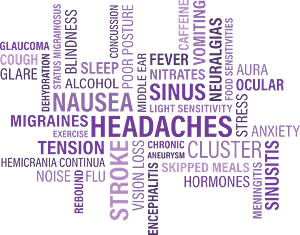Are you suffering from headache almost every day? You must probably be suffering from migraine. Migraine is a primary type of headache that is recurring in nature with a throbbing and pulsating painful sensation, usually affecting one side of the head. The exact cause of migraine is still unknown, although it is said to be the result of an abnormal brain activity affecting brain signals, blood vessels and chemicals.
Triggering Factors
 Migraine can recur anytime because of a variety of triggers which includes dietary, hormonal, environmental, physical, medicinal, and many other factors. Because triggers can vary from one individual to another, it is recommended that a migraine sufferer keep a diary on each onset of a migraine attack. This will help identify the triggering factor of migraine of an individual.
Migraine can recur anytime because of a variety of triggers which includes dietary, hormonal, environmental, physical, medicinal, and many other factors. Because triggers can vary from one individual to another, it is recommended that a migraine sufferer keep a diary on each onset of a migraine attack. This will help identify the triggering factor of migraine of an individual.
With the various factors that can trigger a migraine attack, you may not wonder why you may have a headache almost daily.
Symptoms
The primary manifestation of migraine is a moderate to severe throbbing pain on one side of the head, although it may involve both sides in some cases. It can also affect the neck and face. Generally, the symptoms are diverse with increased light and sound sensitivity as a unique characteristic.
An individual who is about to experience migraine may go through a period called the aura. This period has many manifestations, such as dizziness, numbness or tingling sensation, visual problems, and loss of consciousness. Symptoms vary, and this should be one of the things that are documented in a diary of a person with migraine.
Stages
Migraine can develop hours or even days before the headache stage. When there is a visible change in mood, energy, and appetite, you may be quite sure of a migraine attack. This is called the prodromal stage.
An individual may then go through the aura stage, where he will feel more pronounced symptoms which can last up to an hour before the headache stage. You may endure the headache for up to three days. When signs are gradually fading, you are now on the resolution stage, a stage that is characterized by a feeling of tiredness and fatigue.
Diagnosis
Because migraine has no exact cause, it may be difficult to diagnose. It may take some time to establish that the condition a patient is going through is migraine as there is no specific test to diagnose this headache disorder.
Treatment
 One treatment option that has popped up in recent times is the use of CBD oil, and it has been proven to derive alleviation from the symptoms of migraine.
One treatment option that has popped up in recent times is the use of CBD oil, and it has been proven to derive alleviation from the symptoms of migraine.
There is still no universal treatment for migraine. While there are many forms of medications, they are generally used for the management of pain. Treatment can include pain killer and anti-sickness drugs and alternative medicines like acupuncture, massage therapy, and aromatherapy.







